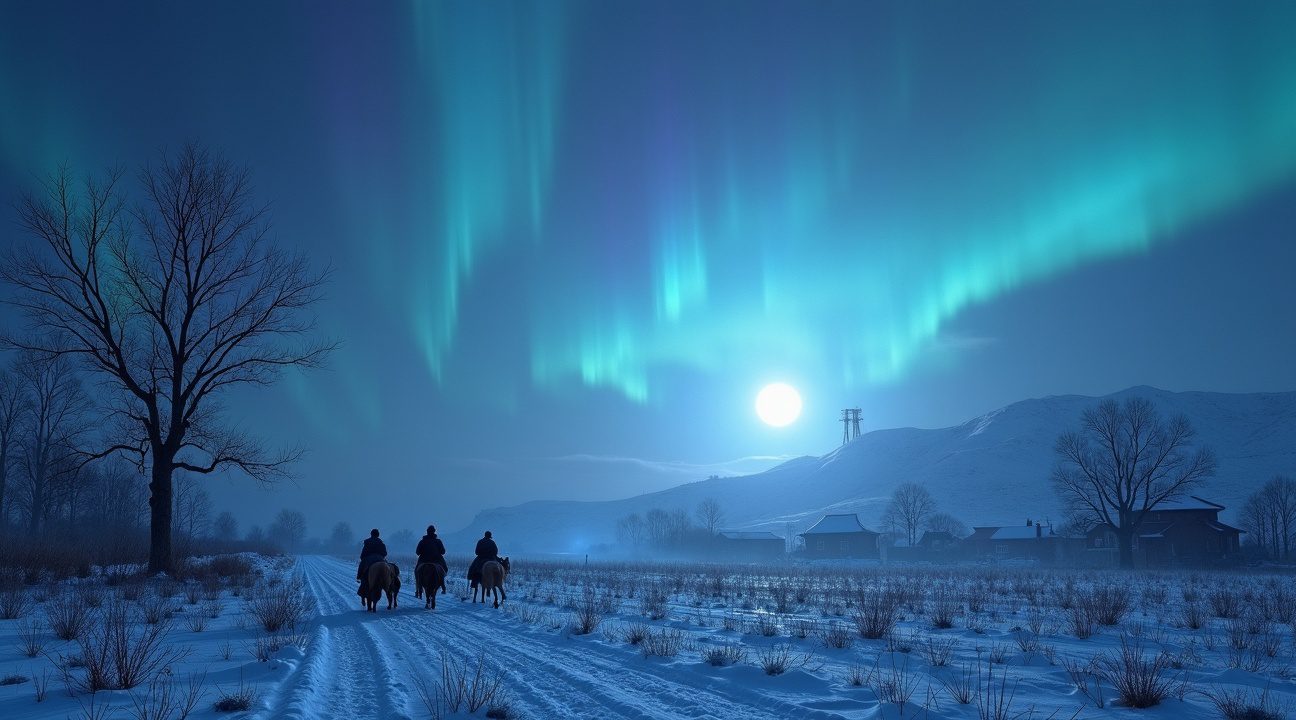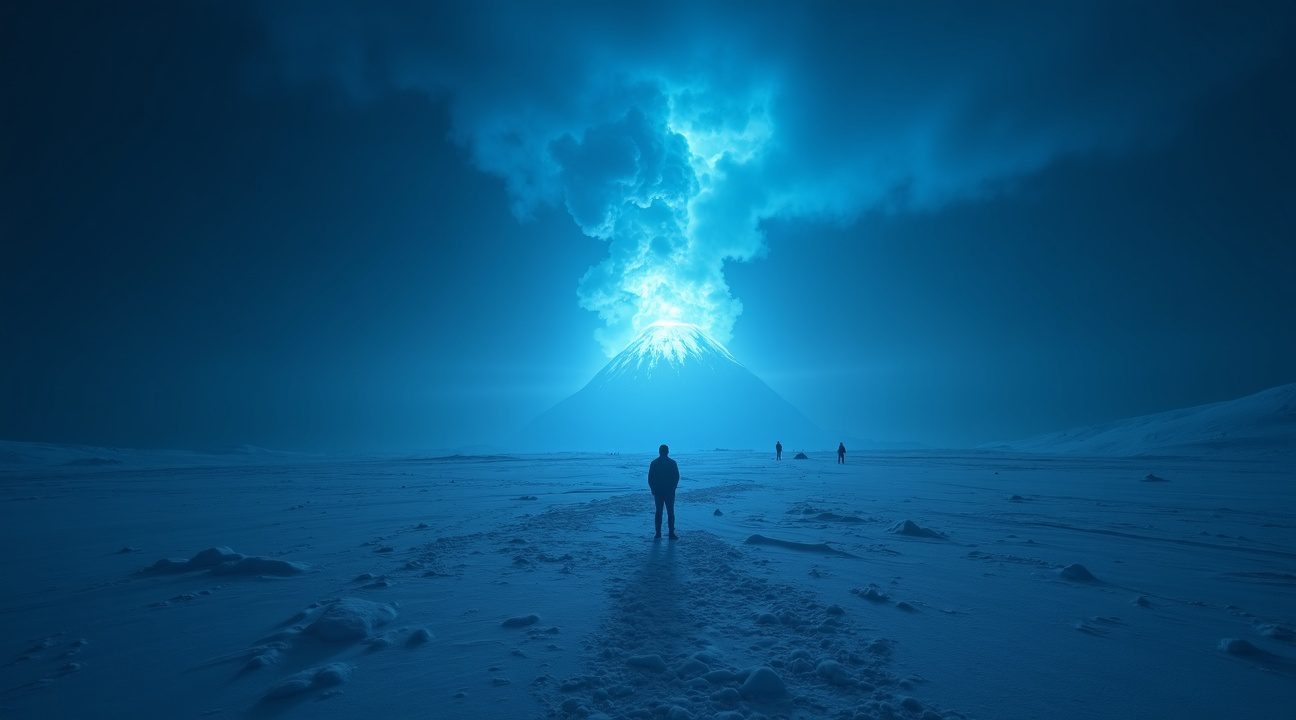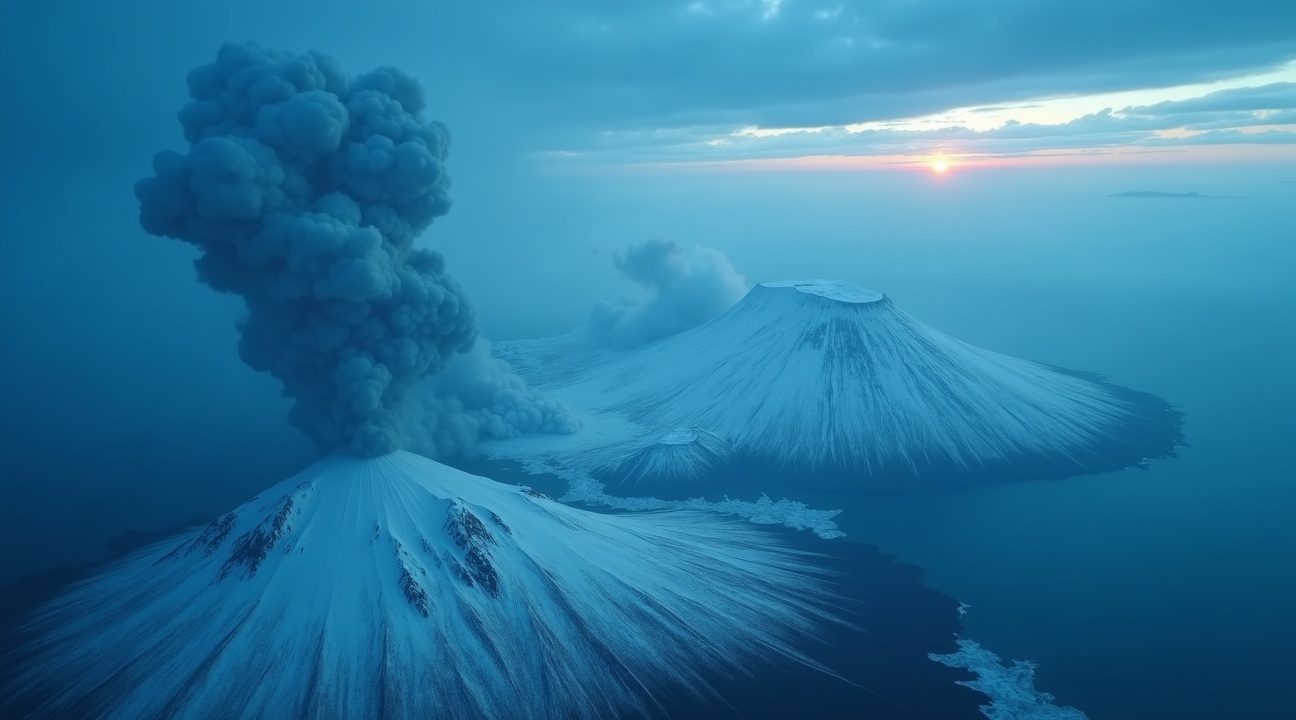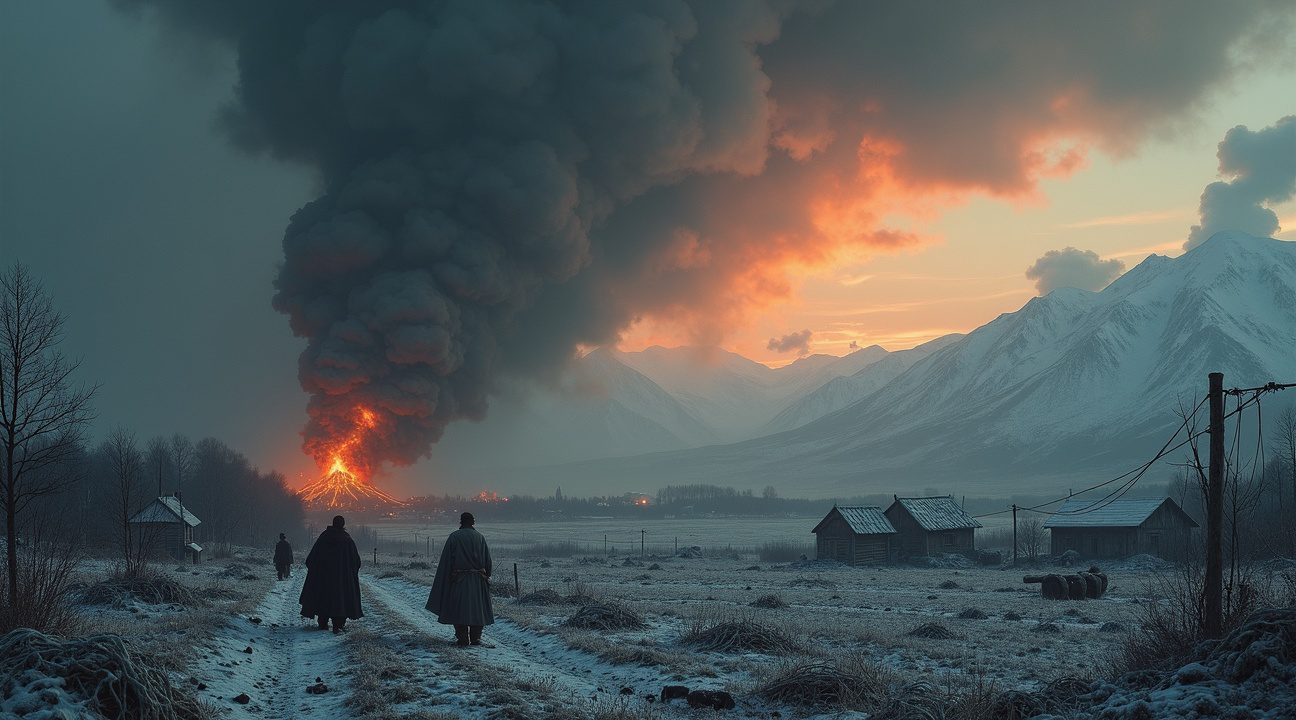Scientists from the University of St. Andrews cracked one of history’s most perplexing climate mysteries in December 2024: the origin of the 1831 blue sun phenomenon, which had puzzled researchers for nearly two centuries.
The event was caused by a colossal eruption from the Zavaritskii volcano on the remote Simushir Island. This explosive eruption launched approximately 13 teragrams of sulfur into the upper atmosphere, altering the sun’s visual appearance across various continents. The subsequent global cooling event dropped Earth’s average temperature by about 1°C for several months, affecting agriculture and weather systems worldwide.
Using advanced scientific tools like ice core analysis and geochemical fingerprinting, researchers uncovered the source of this historic climatic anomaly. Their investigations involved the study of microscopic volcanic glass shards and sulfur isotopic signatures preserved in polar ice cores collected from Greenland and Antarctica. These innovations finally provided a definitive answer to a mystery that had persisted since the early 19th century.
Key Takeaways
- The 1831 blue sun phenomenon was caused by the eruption of the Zavaritskii volcano on a remote island in the Kuril chain, remaining unknown for nearly two centuries due to its isolation and absence of direct observers.
- Roughly 13 teragrams of sulfur were injected into the stratosphere during the eruption, producing particles that both scattered blue light and reduced incoming solar radiation, which led to a temporary global temperature decrease of 1°C.
- Researchers used advanced ice core techniques to solve the climate mystery, analyzing cryptotephra and sulfur isotopes embedded in Greenland and Antarctic ice layers.
- The eruption triggered significant consequences, including widespread crop failures, deadly famines, and social unrest across the Northern Hemisphere between 1831 and 1833.
- This discovery improves current volcanic monitoring and strengthens climate projection models, showing that even eruptions from remote volcanoes can have far-reaching global implications.
To learn more about the institution behind this research, visit the University of St. Andrews website.
The Day the Sun Turned Blue and the World Froze
I remember learning about extraordinary natural phenomena that changed history, but nothing quite prepared me for the story of 1831’s blue sun. That year marked one of the most dramatic climate events in recorded history, when a massive volcanic eruption triggered a global cooling event that dropped Earth’s temperature by approximately 1°C (1.8°F).
The eruption sent enormous quantities of sulfur dioxide and volcanic dust into the atmosphere, creating an unprecedented spectacle that left witnesses across multiple continents stunned. People from Europe to China, and from the United States to the Caribbean, reported seeing the sun appear in shades of blue, purple, and green rather than its familiar golden hue. This wasn’t just a local curiosity—the optical phenomenon stretched across vast geographic regions, affecting how sunlight scattered through the particle-laden atmosphere.
Unprecedented Weather and Its Devastating Impact
The climate consequences proved far more severe than the visual spectacle. Crop failures plagued agricultural regions worldwide as temperatures plummeted and growing seasons shortened dramatically. These failures triggered widespread famines that lasted for several years, demonstrating how volcanic aerosols can fundamentally alter global weather patterns.
Even celebrated figures of the time documented the extraordinary conditions. German composer Felix Mendelssohn described experiencing “desolate weather” and encountering “deep snow” in the Alps during what should have been summer months. His firsthand account illustrates just how drastically the eruption disrupted normal seasonal patterns across Europe.
The event contributed to what historians now recognize as part of the Little Ice Age, a period of cooling that affected global climate patterns for centuries. Scientists have recently discovered that these atmospheric changes created a cascading effect that influenced weather systems far beyond the immediate aftermath of the eruption.
Modern research has revealed that volcanic aerosols act like a massive atmospheric filter, scattering different wavelengths of sunlight and reducing the amount of solar energy reaching Earth’s surface. This scattering effect explains both the blue sun phenomenon and the dramatic temperature drop that followed. The sulfur dioxide particles particularly affected how blue light traveled through the atmosphere, creating the surreal celestial display that captivated and terrified observers worldwide.
Understanding this 1831 event helps scientists better predict how future volcanic eruptions might impact global climate systems, providing crucial insights for climate modeling and disaster preparedness in our modern world.

The 200-Year Mystery That Puzzled Scientists
I’ve witnessed firsthand how volcanic eruptions can leave lasting fingerprints in our planet’s history, but few mysteries have captivated the scientific community quite like the 1831 climate catastrophe. Despite clear evidence pointing to a massive volcanic trigger behind the blue sun phenomenon and global cooling, researchers couldn’t pinpoint which specific volcano caused this dramatic climate disruption for nearly two centuries.
Early Theories and Scientific Dead Ends
Scientists initially focused their attention on several volcanic candidates across the globe. Italy’s Ferdinandea volcano emerged as an early suspect, given its documented activity during the period. Similarly, researchers examined the Babuyan Claro volcano in the Philippines as another potential culprit. However, each hypothesis fell short of providing definitive proof, leaving the scientific community frustrated and divided.
The challenge lay not in identifying that a volcanic eruption occurred, but in establishing which specific volcano unleashed enough sulfur dioxide and ash into the atmosphere to trigger such widespread climate effects. Traditional historical records proved insufficient, and the technology needed to solve this geological puzzle simply didn’t exist in earlier decades.
Modern Breakthrough Through Ice Core Analysis
The mystery finally found its resolution through sophisticated ice core sampling techniques that revolutionized our understanding of ancient volcanic events. Scientists extracted samples from both Greenland and Antarctica, analyzing layers of ice that had preserved atmospheric conditions from 1831 like a frozen time capsule.
Researchers employed advanced methods to examine volcanic ash, known as cryptotephra, embedded within these ice cores. They also conducted detailed analysis of sulfur isotopic compositions, searching for a unique geochemical fingerprint that would connect the atmospheric disturbance to its volcanic source. Scientists have discovered that each volcano produces distinct chemical signatures, much like human fingerprints.
These cutting-edge ice core geochemistry methods enabled researchers to match the atmospheric deposits from 1831 to a specific volcanic source. The process involved comparing microscopic particles and chemical ratios against known volcanic profiles from around the world. This painstaking analysis ultimately revealed the true culprit behind one of history’s most dramatic climate events.
The resolution of this mystery demonstrates how modern scientific techniques can unlock secrets that have puzzled researchers for generations. Advanced analytical methods continue to provide new insights into historical climate events, helping us better understand the powerful forces that shape our planet’s atmospheric conditions.

The Remote Culprit Finally Revealed
After nearly two centuries of scientific speculation, researchers have finally identified the volcanic culprit behind the world’s mysterious blue sun and global cooling event of 1831. The answer lies in one of Earth’s most isolated volcanic regions—the Zavaritskii volcano on Simushir Island in the Kuril Islands.
This remote nested caldera, situated northwest of Japan in the disputed territory between Russia and Japan, unleashed a catastrophic magnitude 5–6 eruption that changed the planet’s climate for months. Scientists now understand that this single volcanic event released approximately 13 teragrams of sulfur into the stratosphere, creating a massive atmospheric barrier that blocked sunlight across the globe.
Solving the Scientific Puzzle
The breakthrough came when researchers discovered compelling geochemical evidence linking the 1831 climate anomaly directly to Zavaritskii’s most recent major eruption. Earlier theories that pointed to other volcanic candidates were systematically ruled out through careful analysis. Scientists found exact chemical matches between volcanic material from Zavaritskii and microscopic shards preserved in polar ice cores from the 1831 period.
Radiocarbon dating methods confirmed that this devastating Simushir Island eruption occurred within the past 300 years, perfectly aligning with the historical records of the blue sun phenomenon. The 13 Tg of sulfur emissions created aerosol particles in the stratosphere that scattered blue light while absorbing other wavelengths, giving the sun its eerie blue appearance.
I find it fascinating how this discovery connects to other scientific breakthroughs that solve long-standing mysteries through advanced analytical techniques. The remote location of the Kuril Islands explains why this volcanic source remained hidden for so long—these islands are extremely difficult to access and study comprehensively.
The magnitude of sulfur emissions from this single eruption demonstrates the incredible power that remote volcanic events can have on global climate systems. Unlike more famous volcanic eruptions that occurred in populated areas, Zavaritskii’s explosion went largely unnoticed at the time, despite its worldwide atmospheric impact that lasted for months.

Global Climate Chaos and Human Suffering
The 1831 Zavaritskii eruption unleashed a radiative forcing of approximately −2 ± 1 W/m², a measurement that puts this catastrophic event on par with the 1991 Mount Pinatubo eruption. This comparison provides a modern reference point for understanding the sheer magnitude of volcanic cooling that gripped the planet nearly two centuries ago.
A Perfect Storm of Climate Conditions
The timing couldn’t have been worse for humanity. Occurring near the end of the Little Ice Age, the Zavaritskii eruption compounded already frigid conditions that had plagued the Northern Hemisphere for centuries. The volcanic event represents one of the most significant volcanic-induced cooling periods of the past 200 years, creating a double blow that would devastate societies across multiple continents.
The eruption’s impact extended far beyond immediate temperature drops. Scientists think the combination of existing cold conditions with sudden volcanic cooling created an unprecedented climate anomaly that lasted from 1831 to 1833.
Widespread Agricultural Collapse and Social Upheaval
Crops failed catastrophically across the Northern Hemisphere as temperatures plummeted and growing seasons shortened dramatically. The agricultural devastation triggered widespread famine that rippled through communities from Europe to Asia and the Americas. Historical documents from this period paint a grim picture of societies struggling to survive in conditions unlike anything experienced in living memory.
European records detail massive crop failures that left entire regions without adequate food supplies for months. Asian communities faced similar devastation, with traditional farming cycles completely disrupted by the extended cold period. In the Americas, both indigenous populations and colonial settlements suffered as familiar agricultural patterns collapsed under the volcanic winter’s influence.
The climate anomaly created a cascade of human suffering that extended well beyond simple hunger. Communities that had developed intricate social and economic systems suddenly found themselves unable to sustain basic needs. Trade routes became unreliable as transportation faced harsh conditions, and many regions experienced significant population displacement as people searched for more hospitable areas.
Historical accounts from the 1831-1833 period consistently describe widespread societal hardship that touched every aspect of daily life. The combination of failed harvests, extreme cold, and disrupted social systems created conditions that would reshape entire regions and influence political developments for years to come. This volcanic winter stands as a stark reminder of how quickly natural forces can transform human civilization on a global scale.

How Scientists Cracked the Case
A research team from the University of St. Andrews in the U.K. finally solved this 193-year-old mystery through groundbreaking detective work published in December 2024 in the journal PNAS. Their investigation demonstrates how modern scientific techniques can uncover the secrets behind historical climate catastrophes that seemed impossible to trace.
Ice Core Analysis Reveals Hidden Clues
The breakthrough came through sophisticated ice core analysis that revealed volcanic fingerprints preserved in polar ice for nearly two centuries. Scientists discovered that ice cores contained microscopic volcanic glass shards called cryptotephra—essentially frozen evidence of the 1831 eruption. These tiny fragments acted like geological fingerprints, maintaining their chemical signatures despite being transported thousands of miles from their source.
The research team also analyzed sulfur isotopic signatures embedded within the ice cores, which provided additional confirmation of volcanic activity. Much like how scientists study brain patterns to understand mysterious phenomena, these researchers examined chemical patterns to decode past climate events. This dual approach of studying both cryptotephra and sulfur isotopes created an unprecedented level of scientific certainty about the eruption’s source and timing.
Matching Evidence to the Zavaritskii Eruption
The scientists achieved their breakthrough by definitively linking polar geochemical records with the 1831 Zavaritskii eruption on Simushir Island. This remote volcanic event had remained hidden from historical records because no human witnesses existed to document it. The eruption occurred on an uninhabited island in the Kuril chain, making it virtually invisible to 19th-century observers.
By matching the chemical signatures found in ice cores to specific volcanic sites, the research team could trace the global climate disruption back to its source. The sulfur compounds released during the Zavaritskii eruption created the atmospheric conditions that turned the sun blue and triggered months of global cooling. This volcanic material remained suspended in the atmosphere for extended periods, scattering sunlight in ways that created the eerie blue appearance observers reported worldwide.
The University of St. Andrews team’s work represents more than just solving a historical puzzle. Their findings showcase how studying remote, hidden volcanic eruptions can significantly improve climate forecasting and volcanic risk assessment. Understanding these past events helps scientists better prepare for future volcanic catastrophes that could similarly disrupt global climate patterns.
This research methodology opens new possibilities for investigating other unexplained historical climate events. Scientists can now apply similar techniques to study previously unexplored geological formations and uncover additional climate mysteries from Earth’s past.
The implications extend beyond historical curiosity into practical climate resilience planning. By identifying how specific volcanic eruptions created global climate disruptions, scientists can better model potential future scenarios and develop more accurate climate prediction models. This knowledge proves essential for understanding climate vulnerability and preparing communities for similar events that might occur in the future.
The success of this investigation relied heavily on advances in analytical chemistry and ice core preservation techniques. Modern equipment can detect incredibly small concentrations of volcanic materials that previous generations of scientists couldn’t identify. These technological improvements allow researchers to extract far more information from ice core samples than ever before possible.
The research also highlights the importance of international scientific collaboration in climate studies. Ice cores from multiple polar locations provided the comprehensive dataset necessary to solve this mystery. Different ice core sites preserved slightly different aspects of the volcanic signature, and combining these sources created the complete picture needed for definitive identification.
This breakthrough demonstrates how space-age analytical techniques can unlock secrets from Earth’s climate history. The same precision and methodology used in studying distant celestial bodies now helps scientists understand our planet’s past climate catastrophes.

What This Discovery Means for Our Future
The revelation about the 1831 blue sun phenomenon represents a significant breakthrough in climate science advancement, demonstrating how modern analytical techniques can unlock mysteries that have puzzled researchers for nearly two centuries. Scientists can now piece together historical climate events with unprecedented accuracy, allowing them to better understand how volcanic eruptions create cascading effects across the globe.
This discovery fundamentally changes how researchers approach volcanic monitoring and future preparedness strategies. The 1831 event proves that relatively unknown volcanic eruptions can trigger worldwide climate disruptions, forcing scientists to expand their surveillance networks beyond traditionally monitored volcanoes. Remote eruptions, previously considered inconsequential to global climate patterns, now demand serious attention from scientific think tanks and monitoring agencies worldwide.
The implications for global impact assessment are profound. Climate models must now account for the potential of obscure volcanic events to dramatically alter atmospheric conditions and trigger extended cooling periods. Historical climate research has revealed that single eruptions can fundamentally disrupt agricultural cycles, economic systems, and human societies for months or even years.
Enhanced Monitoring Systems and Early Warning Networks
Modern volcanic monitoring systems benefit enormously from understanding the 1831 event’s global reach. Scientists now recognize several key indicators that require continuous observation:
- Atmospheric particulate measurements that can detect volcanic ash and sulfur compounds at unprecedented distances
- Satellite monitoring of remote volcanic regions previously considered low-priority
- Advanced climate modeling that incorporates historical data from events like the 1831 eruption
- International cooperation protocols for sharing volcanic activity data across borders
- Enhanced agricultural monitoring systems to detect early signs of climate-related crop failures
The 1831 case study provides a blueprint for how future catastrophic volcanic eruptions might unfold. Researchers can now develop more accurate prediction models by incorporating the specific atmospheric and climatic patterns observed during this historical event. This knowledge enables governments and international organizations to create better emergency response plans and food security protocols.
Future preparedness strategies must acknowledge that volcanic events don’t respect geographical boundaries. The 1831 eruption’s ability to turn the sun blue and freeze global temperatures for months demonstrates nature’s capacity to create worldwide emergencies from single geological events. Emergency management agencies now understand they must prepare for scenarios where remote volcanic activity triggers domestic climate disasters.
Scientific institutions are developing new approaches to historical climate research, using the techniques that solved the 1831 mystery to investigate other unexplained climate anomalies. These methods help researchers identify patterns and warning signs that might predict future volcanic impacts. The breakthrough also emphasizes the importance of maintaining comprehensive geological and atmospheric records for future analysis.
Climate scientists now advocate for expanded international monitoring networks that can detect and track volcanic emissions across vast distances. The 1831 discovery reveals how potentially home threats can emerge from unexpected locations, making global surveillance essential for early warning systems.
The research breakthrough also highlights the critical need for sustained funding in climate science advancement and volcanic monitoring programs. Understanding events like the 1831 blue sun requires long-term data collection and analysis capabilities that span decades or centuries. Investment in these programs today could prevent widespread disasters in the future.
Modern technology allows scientists to simulate how similar eruptions might affect current global systems. These simulations help governments prepare contingency plans for scenarios involving extended climate disruptions, food shortages, and economic instability. The 1831 event serves as a powerful reminder that nature possesses the ability to fundamentally alter human civilization through sudden, dramatic climate changes.
Sources:
Popular Mechanics (“200 Years Ago, the Sun Mysteriously Turned Blue. Scientists Finally …”)
YouTube: “Volcanic Eruption in 1831 that Cooled Planet Just Identified”
IFLScience (“In August 1831, The Sun Appeared Blue – And We Now Know Why”)
Smithsonian Magazine (“Scientists Find the Mysterious Source of the Massive 1831 Volcanic Eruption That Cooled Earth and Made the Sun Appear Blue”)
LiveScience (“Mysterious climate-changing eruption that turned the sun blue traced to remote Pacific island”)


